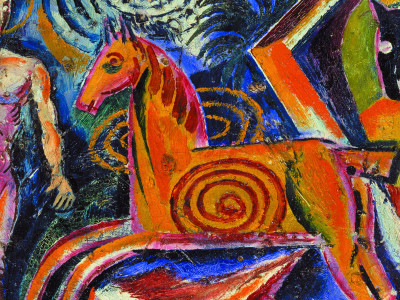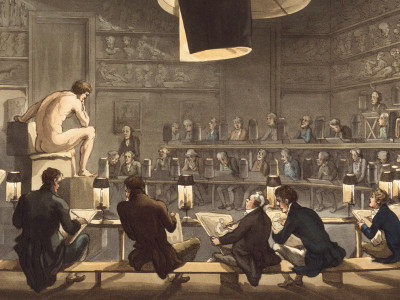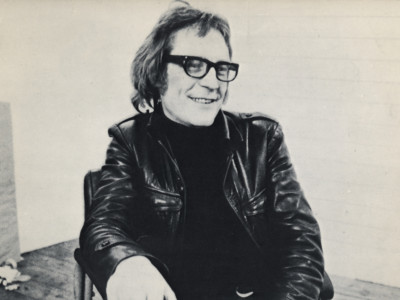
Bill Viola / Michelangelo: art as a search for meaning
By Richard Holloway
Published on 7 December 2018
We asked four writers to respond to key themes in ‘Bill Viola / Michelangelo’. On the subject of mortality, the former bishop Richard Holloway writes that art and religion are driven onwards by the fact of our death.
From the Winter 2018 issue of RA Magazine, issued quarterly to Friends of the RA.
In Waiting for Godot Samuel Beckett reminded us that our mothers gave birth to us "astride the grave". We all know that, sooner or later, that's where we will finish. On Earth, maybe even in the whole universe, this knowledge seems to be unique to us. It is hard to fathom the inner lives of the other animals on our little planet, but they do not appear to live with the constant knowledge that one day they will die. We do. And it accounts for our obsession with the health of our bodies and whether they are showing any of the signs that presage our dissolution, hauntingly captured in Bill Viola's video installation Man Searching for Immortality/ Woman Searching for Eternity (2013), in which an elderly man and woman use torches to explore their bodies for evidence of illness.
And it is the pressure and pain of this knowledge of our own mortality that seems to have got us thinking about ourselves and the world into which we were thrust at birth. We are passing guests on Earth and we can't help wondering where we came from and where we will go when the visit is over. Is the grave it, a literal dead-end? Or is it a portal to other kinds of life beyond? These insistent questions have spurred two separate but related compulsions in us.
One is the urge to ponder and pour over the meaning of our own existence. The American philosopher Arthur Danto described the human animal, in a Latin phrase, as an ens representans, a being that endlessly repeats its experience of life back to itself, picturing it, telling its story. Give children crayons and paper, and they'll draw their mummy and daddy and the cat on the mat before the fire. Listen to people on the bus going home from work, and they'll be telling their day over again to their friends. Novelists possess this urge for representation to an obsessional degree, rehearsing the complexities of the human condition in a form many of us constantly return to, even though the plots go on repeating themselves. Artists are also compulsive reflectors of what is presented to them in life. Cézanne even said the landscape thought itself in him. All art flows from this need to reflect the tumultuous realities that present themselves to our senses, to wonder at them and seek patterns of meaning in them.

Christ on the Cross with the Virgin and St John, c. 1560–64

Man Searching for Immortality/Woman Searching for Eternity, 2013
Performers: Luis Accinelli, Penelope Safranek
But the art form we call religion reverses this process. The founders of religion did not hold up a camera to the universe to copy and reflect on what they saw. For them it was the other way around. They thought of themselves as conduits specially chosen by the creative intelligence behind the universe to reveal its meaning and purpose to them and through them to us. For most religions we are characters in a story crafted by a transcendent author over whose intentions we have little or no control. And it is always death that drives the plot: how we pass our sojourn on Earth will determine what awaits us on the other side of death's dark portal.
But there is a mysterious rumour in religion that gives this narrative another twist. Either there is no meaning to the world's sorrow because no mind meant it and no hand wrote it, and we live and die within that absurdity. Or there was an original author that knows itself guilty of creating such woe and it dies in the fall of every sparrow. This idea of the dying or crucified god that takes to itself the sins of the world appealed to the spirituality of Michelangelo. He glimpsed the truth that it is the creator, not the creature, who must bear the blame. This is not a truth that can be easily explained, which is why theologians distrust it. But sometimes artists get it and try to express it, as Michelangelo does in his drawing Christ on the Cross with the Virgin and St John (1560-64). Through the shifting, indeterminate shapes of the crucified a redemptive sorrow expresses itself.
Even if you believe the 'revelations' of prophets only unveil the contents of their own unconscious fears and longings, religious stories still have much to teach us. A good way to think about religious revelation is as a Rorschach test that maps humanity's psychic geography. And the big reveal is always our anxiety about death and where it might take us. Death is religion's great prompter in the wings.
Which brings me to our other death-driven compulsion. Not sure where we came from or where we are going, we can at least leave a mark or sign on the Earth to show that once we were here – something else the other animals don't bother about. Like us, they leave their dust behind, but we leave more than our dust. We leave the books we wrote to try to explain ourselves to ourselves. We leave pictures of lovers whose beauty once stole our fading hearts. And, in Bill Viola's words, we leave "the enormous resonant stone halls" of the medieval cathedrals we built centuries ago to bear witness to our enduring ache for a transcendence that may or may not be waiting for us when we die. Through us the world has been filled with art that long outlives our own brief and transient being. And when we are long gone it will make us present again to generations yet to be born astride the graves that we will have already fallen into.
So, isn't it worth a thought that death has been art's greatest patron and curator? Death that stimulates our deepest longings? Maybe it's worth more than a thought. Maybe it is even worth a thank you.
Richard Holloway is a writer and former Bishop of Edinburgh. His latest book is Waiting for the Last Bus: Reflections on Life and Death.
Bill Viola / Michelangelo: Life, Death, Rebirth. Main Galleries, Burlington House, Royal Academy, 26 January – 31 March 2019. Exhibition organised by the Royal Academy of Arts, London in partnership with Royal Collection Trust and with the collaboration of Bill Viola Studio.
Related articles

Visions from Ukraine
19 June 2024

10 RA Schools stories through the centuries
16 May 2024

In memoriam: Mick Moon RA
1 May 2024